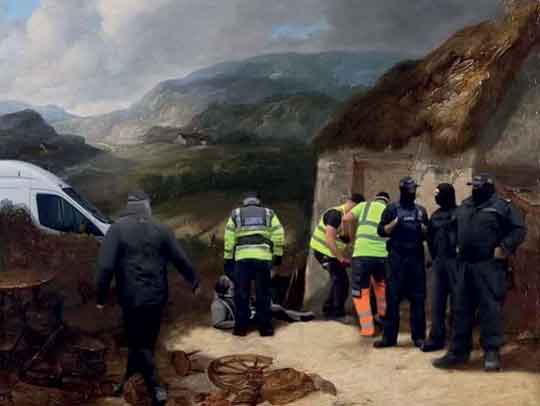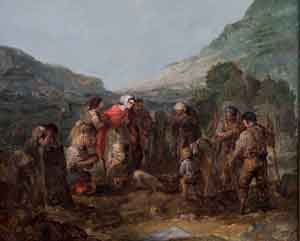By Niamh O’Sullivan
The doctored eviction image shared by Sinn Féin’s housing spokesman Eoin Ó Broin, originally executed in 2021 by the artist Adam Doyle, a.k.a. Mála Spíosraí/Spice Bag, was inspired by a 2018 eviction in Dublin’s North Frederick Street at which masked gardaí assisted. It struck a deep chord, leading to calls for an apology from the Association of Garda Sergeants and Inspectors and Justice Minister Simon Harris. Eviction evokes bad memories of Famine times in Ireland; Spice Bag reissued the image when the government terminated the eviction ban in March 2023. The image showed gardaí superimposed on a nineteenth-century painting, Eviction (Crawford Art Gallery, Cork), attributed to the artist Daniel Macdonald (1821–53), but there is an interesting flick in the tail of this story.

The use of a Famine eviction scene from the 1840s to comment on the current housing crisis sparked indignation, but remix in art is nothing new. Reverentially, satirically or ironically, artists reference the work of other artists to establish iconographical lineage, to display their cultural learning or to graft a political point into a new context. While it is rare for a nineteenth-century Irish painting to provoke such visceral responses, the very power of this subject-matter made the political commentary all the more contentious.
From its auction in 2010 as ‘Irish School, c. 1850’, Eviction steadily attracted the conviction—based on comparative stylistic analysis with other artwork—that it was by Macdonald. Macdonald had been the subject of a major exhibition in the Ireland’s Great Hunger Museum in the United States in 2016 that attracted interest, not least from the New York Times. His reputation was riding high, and there was perhaps increasing receptivity to assigning unsigned comparable work to him.

Macdonald executed a number of fascinating paintings relating to Irish folklore and the Famine (and is soon to be the subject of a feature film). Recent research, coincidental to Ó Broin’s circulation of the painting to highlight the lifting of the eviction ban, reveals that the painting attributed to Macdonald is in fact by the almost unknown artist John Joseph Trac[e]y (1813–73). And The Eviction can now be definitively identified as A Scene of Bygone Days (1845) by Tracy (front cover). Paintings of evictions during the Famine are rare—all the more reason to establish the bona fides of such images. The reassignment reinforces the orthodoxy that stylistic analysis alone is not always adequate grounds for an attribution, but the corollary, that we now have a new Irish artist of considerable interest, is a welcome outcome.
It is important that cultural institutions update their attributions (when appropriate) to ensure the non-perpetuation of inaccuracies. The Crawford, on the foot of this new research, welcomes the opportunity to do that.
Apart from the current use of the eviction painting, the new research is an interesting exercise in art-historical methodology. In 2018 a painting called The Village Funeral: An Irish Family by a Graveside during the Great Famine was auctioned by Adam’s. Based on the stylistic analysis of the Eviction, The Village Funeral was identified as another Macdonald and was also acquired as such by the Crawford. Chain attributions tend to lead to increasing certainties, demonstrating the precariousness of stylistic analysis alone. Both paintings are unsigned. And there are indeed clear stylistic consonances between the graveside and eviction scenes, leading to the correct conclusion that the two are by the same hand—but not that of Macdonald.
John Tracy painted both. Their original titles were A Scene of Bygone Days (1845) and The Irish Peasant’s Grave (1843). The identification of Tracy as the correct artist is not simply a reverse exercise in stylistic analysis (which it is) but is also based on documentary material, contemporary newspapers and exhibition records, and a related signature. The perpetuation of a misattribution makes it increasingly difficult to reconstruct an accurate picture of provenance—hence the importance of doing so before further misattributions make it even more difficult to unravel in the future.
Tracy exhibited regularly at the Royal Hibernian Academy and was a member of the Society of Irish Artists. From early classical subject-matter, he began painting rural genre scenes of the life of the Irish peasantry, which makes further research on this artist one of exciting potential (moreover, given the similarities noted between the two artists, the work of Macdonald needs to be revisited, to examine any further attributional issues).
The paintings in question are powerful examples of nineteenth-century realism. Tracy’s Irish Peasant’s Grave was exhibited at the Royal Hibernian Academy in 1843, was purchased and engraved by the Royal Irish Art Union, and was issued as a chromo-lithograph in 1859. The painting was positively reviewed in contemporary newspapers. Having gone unrecorded for over a century, it re-emerged and was sold by Bonhams in 1966 as The Mourners. Subsequently, Bellman’s Auctioneers sold it in 2018, attributing it to a follower of Paul Falconer Poole. The painting was then acquired by the young Irish dealer/scholar Daniel Sheppard, who in turn sold it through Adam’s, who had it independently verified as a Macdonald. Called The Village Funeral: An Irish Family by a Graveside during the Great Famine by Adam’s, it was described as ‘possibly the only depiction of an Irish burial, certainly contemporaneous to the Great Famine’ (although we now know that it was painted in 1843). Daniel Shepherd’s interest in the subject was quickened when he discovered a rare copy of the chromo and realised the error of the attribution at auction. In fact, the chromo deserves approbation in its own right. It was the first in Ireland, a development that was enthusiastically approved by the press at its launch in 1859.
Scene of Bygone Days (1845) also had form. It was exhibited at the Exhibition of the Society of Irish Artists in Dublin, and was a prize-winner at the Royal Irish Art Union. It was later selected for exhibition at the major Irish Exhibition in London in 1888, alongside Aloysius O’Kelly’s magisterial Mass in a Connemara Cabin (National Gallery of Ireland). The exhibition was ambitiously devised, according to the catalogue, to ‘moderate prejudices … at the very root of misunderstanding between people and people’. Nevertheless, Tracy was subsequently all but forgotten, meriting but passing glances in contemporary Irish art history. A retrieval of reputation is anticipated.
Niamh O’Sullivan is Professor Emeritus of Visual Culture, National College of Art and Design.
Further reading
A. Crookshank & the Knight of Glin, The watercolours of Ireland: works on paper in pencil, pastel and paint c. 1600–1914 (London, 1994).
E. Mark Fitzgerald, Commemorating the Irish Famine: memory and the monument (Liverpool, 2013).
P. Murray (ed.), Whipping the herring: survival and celebration in nineteenth-century Irish art (Cork, 2006).
N. O’Sullivan, In the lion’s den: Daniel Macdonald, Ireland and empire (Quinnipiac, 2016).
